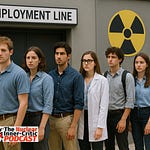Hello, fellow nuclear enthusiasts and environmental stewards!
If you've been following us at HealthPhysics.blog, you know we've been hammering away at the absurdity of America's approach to used nuclear fuel.
The NIC Podcast has argued that treating used nuclear fuel as mere "waste" is not just shortsighted—it's a colossal economic and environmental blunder. Today, with uranium prices under pressure amid proposals for steep tariffs—up to 500%—on Russian imports led by Senator Lindsey Graham and others, the case for reprocessing has never been stronger.
We're sitting on a resource that could power our nation for centuries, yet we're obsessed with burying it.
Enough is enough.
In this post, I'll draw on recent expert analyses and reports to make a compelling argument for ditching permanent storage or disposal in favor of a bold, national reprocessing authority—a public-private partnership that even invites uranium miners to the table. Let's turn "waste" into wealth.
The Wasteful Status Quo: Billions Down the Drain
Let's start with the cold, hard facts. As of 2025, the United States has accumulated approximately 90,000 metric tons of spent nuclear fuel, with around 2,000 additional tons generated annually by operating reactors. This material isn't trash—it's a treasure trove of untapped energy.
Yet, under current policy, we're focused on storing it indefinitely or disposing of it in geologic repositories that may never materialize. Remember Yucca Mountain? You get my point.
A recent Bloomberg video from July 14, 2025, featuring Deep Isolation CEO Rod Baltzer, puts the financial folly in stark relief: American taxpayers are shelling out billions of dollars annually just to manage and store this so-called waste, as Baltzer emphasized. That's on top of tens of billions collected in the Nuclear Waste Fund—estimated to exceed $40 billion—much of which remains unspent due to congressional gridlock, collected from utility ratepayers but trapped by congressional gridlock.
And for what?
To guard material that retains the vast majority—typically over 90%—of its original energy potential? As the World Nuclear Association's updated report on "Processing of Used Nuclear Fuel" (August 2024) points out, SNF is far from spent—it's packed with reusable uranium and plutonium that could fuel advanced reactors and reduce our dependence on foreign imports.
Even alternatives like deep borehole disposal, which some tout as a localized solution, fall short. Sure, it sounds appealing: Drill deep holes at plant sites and drop in the waste. As reported in May 2025 coverage by ANS, Deep Isolation validated a specialized canister for TRISO spent fuel—highlighting some of the engineering complexity tied to borehole disposal methods. This approach involves technical challenges, including the need for specialized canisters.
Broader industry insights suggest it would require building expensive hot cells to repackage fuel from existing dry storage canisters into borehole-compatible formats. The costs? Prohibitive, potentially adding billions more to an already bloated tab.
Why repackage for burial when we could reprocess for reuse? It's like throwing away a half-full gas tank because refilling it seems too complicated.
This storage-first mindset isn't just expensive—it's environmentally irresponsible.
By not reprocessing, we perpetuate a cycle of mining more uranium, which scars landscapes, encroaches on aquifers, and consumes significant amounts of energy. Meanwhile, amid the looming 500% tariffs on Russian uranium, which in recent years has accounted for about 20–24% of U.S. enriched fuel supplies, domestic production lags far behind demand. We're facing shortages that could hamstring our nuclear renaissance, especially as data centers and AI boom drive energy needs skyward. It's time to stop burying our heads—and our resources—in the sand.
The Inherent Value in "Spent" Fuel: A Resource, Not Waste
Imagine if we treated oil the same way: Extract it, use 5% of its energy, then seal the rest in barrels and bury them forever.
Sounds ridiculous, right?
Yet that's exactly what we're doing with used nuclear fuel. The Yale Environment 360 article from April 2, 2025, "Recycling Nuclear Waste: A Win-Win or a Dangerous Gamble?" lays it out beautifully: Reprocessing could extract enough energy from existing SNF stockpiles to power the U.S. for over 150 years at current consumption rates. That's not hyperbole—it's science.
Reprocessing involves chemically separating usable fissile materials like uranium-235 and plutonium-239 from the true waste products. Countries like France have been doing this successfully for decades, recycling fuel into mixed-oxide assemblies that go right back into reactors.
According to the World Nuclear Association, this can significantly reduce the volume of high-level waste—by as much as 90% according to industry estimates—and extend the availability of nuclear fuel. In the U.S., startups like Oklo and Curio are pioneering advanced techniques, such as pyroprocessing, which are safer and more efficient than old methods.
A January 2025 report attributed to the Congressional Research Service outlined key considerations around reprocessing, including fuel cycle benefits and proliferation concerns. Advanced reprocessing could make fuel cycles nearly indefinite, slashing the need for new mining and minimizing long-term waste.
But here's the kicker: SNF isn't just energy—it's a strategic asset. With Russian tariffs biting and domestic uranium production at a historic low (we rank 14th globally in resources), reprocessing offers a buffer against supply shocks.
Coverage in sources like Physics Today has emphasized how combining reprocessing with fast reactors could dramatically reduce waste while potentially generating more fuel than consumed—highlighting advanced fuel cycle designs under U.S. lab testing. This isn't pie-in-the-sky tech; it's being tested at labs like Oak Ridge and Argonne.
By eschewing disposal, we reclaim value, bolster energy security, and align with recycling principles that apply to every other resource—from aluminum cans to rare earth metals.
Renewed Momentum: Policy Shifts and the Path Forward
The good news? The winds are shifting. Under the current administration, executive orders have reignited interest in reprocessing, as detailed in Bloomberg Law's article on "Trump Nuclear Orders Show Renewed US Interest in Waste Recycling” (June 16, 2025). These directives mandate a 240-day DOE report on national SNF policy, explicitly evaluating recycling as a cornerstone.
Bipartisan bills, like those from Senators Ted Cruz and Martin Heinrich, are pushing for funding and regulatory reforms to support fuel recycling. Even the ANS urges creating an independent organization to manage SNF, separate from the DOE's bureaucratic quagmire, as echoed in June 2025 ANS commentary urging progress on SNF and high-level waste (HLW) reform, including potential separation of management from DOE oversight.
This momentum builds on global lessons. France's reprocessing program not only powers its grid but exports expertise worldwide.
Why can't America do the same?
The CRS report warns of proliferation risks—separating plutonium could aid weapons programs—but modern methods like those from Curio minimize this by keeping materials in non-weapons-usable forms. Costs? Initial investments are high, but as Yale notes, they pale compared to the trillions in long-term storage and cleanup projected by the DOE (over $300 billion for legacy waste alone).
Critics, like the Union of Concerned Scientists, call reprocessing "dangerous, dirty, and expensive." Fair points, but outdated.
Advanced tech addresses dirtiness (less waste generated), danger (proliferation-resistant designs), and expense (economies of scale in a national program). Plus, doing nothing is costlier: Bloomberg's Baltzer highlights how storage alone costs billions yearly, with no end in sight.
Addressing Challenges: Give Uranium Miners a Seat at the Table
No argument is complete without tackling headwinds, and reprocessing does pose one for a key stakeholder: uranium miners. If we recycle fuel, demand for fresh uranium could drop, potentially hurting mining communities in states like Wyoming and New Mexico.
I've heard from readers in those areas—folks whose livelihoods depend on extraction. But here's where vision comes in: Reprocessing doesn't have to be adversarial; it can be inclusive.
Enter my proposal: A National Reprocessing Authority, modeled as a public-private venture.
Think of it like NASA or the Tennessee Valley Authority, but for nuclear fuel. The federal government provides oversight, funding from the Nuclear Waste Fund, and regulatory streamlining. Private firms—utilities, startups like Oklo, and even defense contractors—handle operations, innovation, and commercialization. Crucially, invite uranium miners and their companies (e.g., Energy Fuels, Uranium Energy Corp.) as equity partners.
Why include miners?
First, fairness: Reprocessing could reduce new mining needs by 20-50% initially, per World Nuclear Association estimates. By giving miners a stake, we mitigate job losses and potentially transition workers to reprocessing facilities.
A 1983 Oak Ridge National Laboratory review noted how former uranium miners in Colorado took jobs in early reprocessing efforts, revitalizing towns like Naturita. Modern plants would create high-skilled roles in separation tech, transport, and maintenance.
Second, benefits: Diversification stabilizes the industry. Miners could pivot to supplying reprocessing feedstocks or even rare earths extracted as byproducts (SNF contains valuable elements like neodymium).
In a heavily tariffed market, a domestic reprocessing loop ensures steady demand, shielding against volatility. The CRS report suggests reprocessing could actually boost mining long-term by enabling advanced reactors that consume more fuel efficiently.
Third, environmental win: Miners know the toll of extraction—tailings ponds, water use, and aquifer encroachment. Partnering in reprocessing promotes sustainability, reducing mining's footprint while creating green jobs.
A public-private structure ensures transparency: the government enforces safety, while private innovation drives efficiency. Bipartisan support could fast-track legislation amending the Nuclear Waste Policy Act to prioritize recycling.
Imagine: Facilities in mining-heavy regions, employing locals, processing SNF into fuel for next-gen reactors. Revenue from exported tech or recycled fuel funds community reinvestment.
It's not just policy—it's progress.
Conclusion: Time to Reclaim Our Nuclear Future
Friends, the era of viewing spent nuclear fuel as a liability must end.
As I've argued in previous podcasts, it's a resource begging to be recycled, especially amid uranium shortfalls and climate imperatives. Drawing from sources like the ANS, Bloomberg, Yale, CRS, and others, the evidence is overwhelming: Reprocessing saves money, secures energy, and shrinks waste.
By establishing a National Reprocessing Authority as a public-private partnership, involving uranium miners, we create an inclusive and innovative ecosystem that benefits all stakeholders.
Let's not bury treasure; let's unleash it.
Contact your representatives, share this post, and join the conversation below. Together, we can forge a nuclear policy worthy of America's ingenuity. What's your take? Ready to recycle?













Share this post